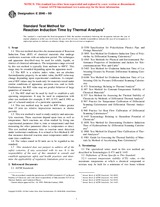Wir benötigen Ihre Einwilligung zur Verwendung der einzelnen Daten, damit Sie unter anderem Informationen zu Ihren Interessen einsehen können. Klicken Sie auf "OK", um Ihre Zustimmung zu erteilen.
ASTM E2046-99
Standard Test Method for Reaction Induction Time by Thermal Analysis
Automatische name übersetzung:
Standard Test Method for Reaction Induktionszeit durch thermische Analyse
NORM herausgegeben am 10.12.1999
Informationen über die Norm:
Bezeichnung normen: ASTM E2046-99
Anmerkung: UNGÜLTIG
Ausgabedatum normen: 10.12.1999
SKU: NS-44099
Zahl der Seiten: 4
Gewicht ca.: 12 g (0.03 Pfund)
Land: Amerikanische technische Norm
Kategorie: Technische Normen ASTM
Die Annotation des Normtextes ASTM E2046-99 :
Keywords:
diferential scanning calorimetry (DSC), differential thermal analysis (DTA), hazard potential, reaction induction time (RIT), reactions, thermal, thermal analysis (TA), thermal stability, ICS Number Code 17.200.20 (Temperature-measuring instruments)
Ergänzende Informationen
| 1. Scope | ||||||||||||||||||||||||||||||
|
1.1 This test method describes the measurement of Reaction Induction Time (RIT) of chemical materials that undergo exothermic reactions with an induction period. The techniques and apparatus described may be used for solids, liquids, or slurries of chemical substances. The temperature range covered by this test method is typically from ambient to 400C. This range may be extended depending upon the apparatus used. 1.2 The RIT is a relative index value, not an absolute thermodynamic property. As an index value, the RIT value may change depending upon experimental conditions. A comparison of RIT values may be made only for materials tested under similar conditions of apparatus, specimen size, and so forth. Furthermore, the RIT value may not predict behavior of large quantities of material. 1.3 The RIT shall not be used by itself to establish a safe operating temperature. It may be used in conjunction with other test methods (for example, E 487, E 537, and E 1981 as part of a hazard analysis of a particular operation. 1.4 This test method may be used for RIT values greater than 15 min (as relative imprecision increases at shorter periods). 1.5 This test method is used to study catalytic and autocatalytic reactions. These reactions depend upon time as well as temperature. Such reactions are often studied by fixing one experimental parameter (that is, time or temperature) and then measuring the other parameter (that is, temperature or time). This test method measures time to reaction onset detection under isothermal conditions. It is related to Test Method E 487 that measures detected reaction onset temperature under constant time conditions 1.6 The values stated in SI units are to be regarded as the standard. This standard does not purport to address all of the safety concerns, if any, associated with its use. It is the responsibility of the user of this standard to consult and establish appropriate safety and health practices and determine the applicability of regulatory limitations prior to use. |
||||||||||||||||||||||||||||||
| 2. Referenced Documents | ||||||||||||||||||||||||||||||
|
Empfehlungen:
Aktualisierung der technischen Normen
Wollen Sie sich sicher sein, dass Sie nur die gültigen technischen Normen verwenden?
Wir bieten Ihnen eine Lösung, die Ihnen eine Monatsübersicht über die Aktualität der von Ihnen angewandten Normen sicher stellt.
Brauchen Sie mehr Informationen? Sehen Sie sich diese Seite an.




 Cookies
Cookies
